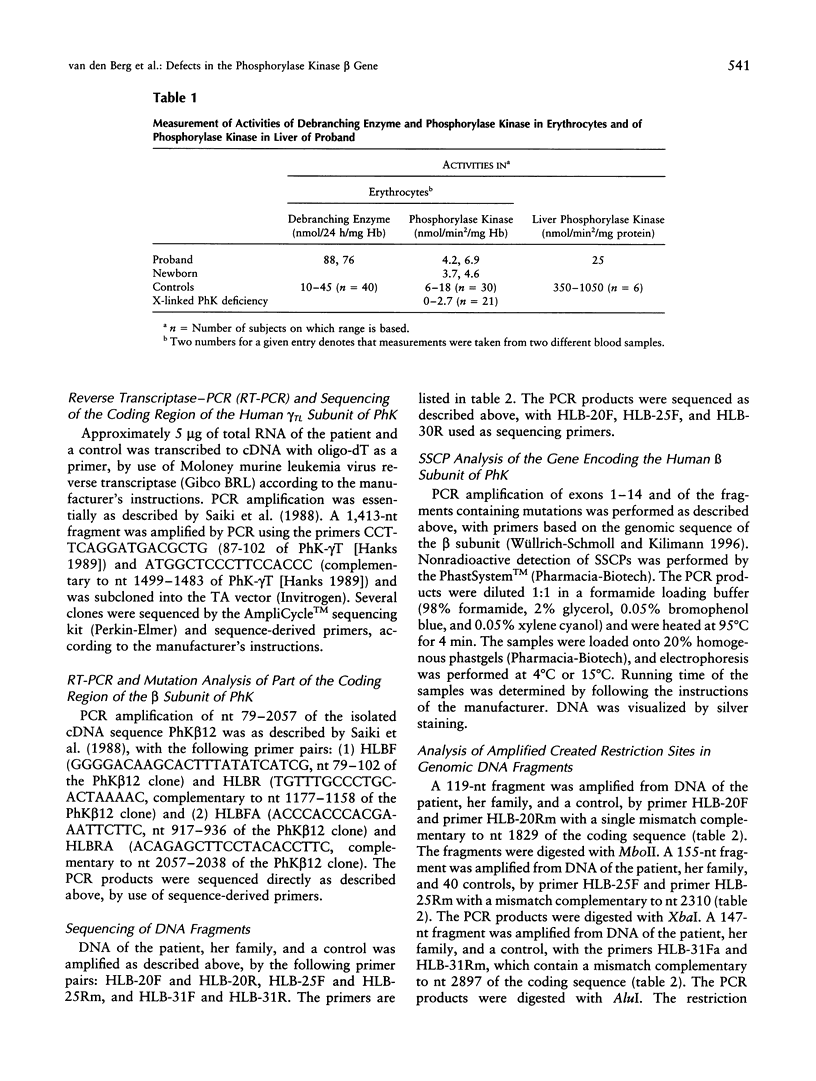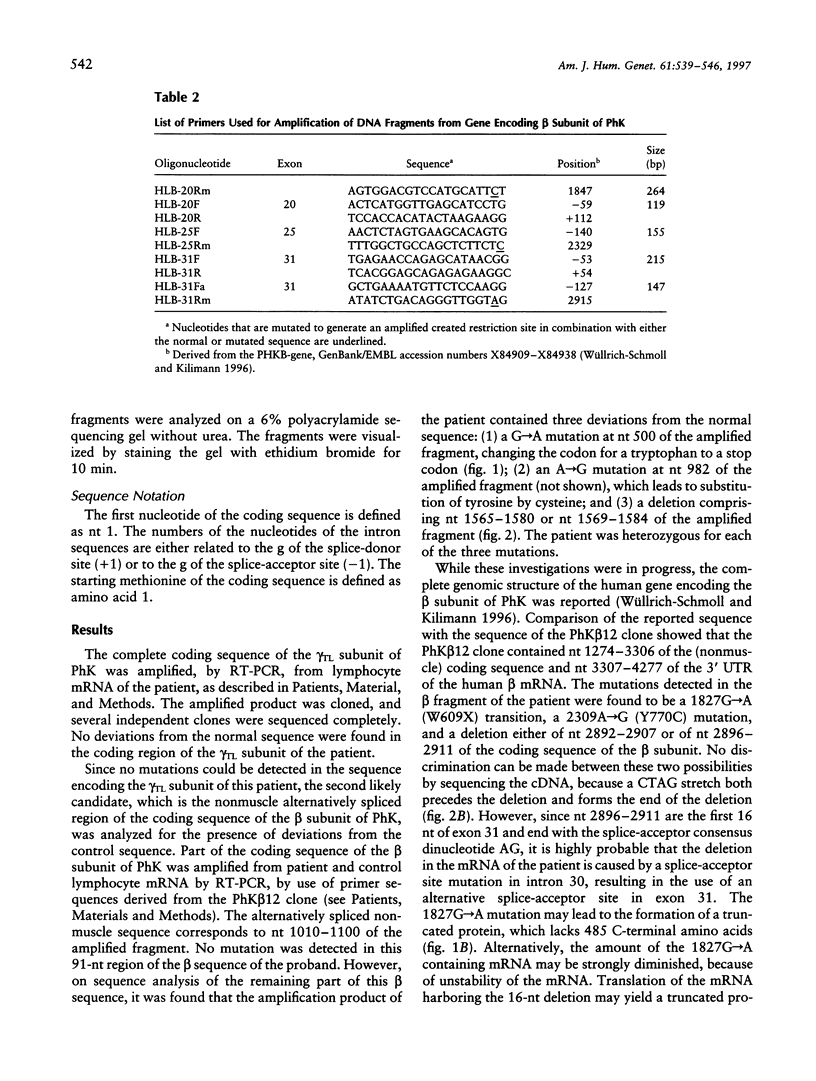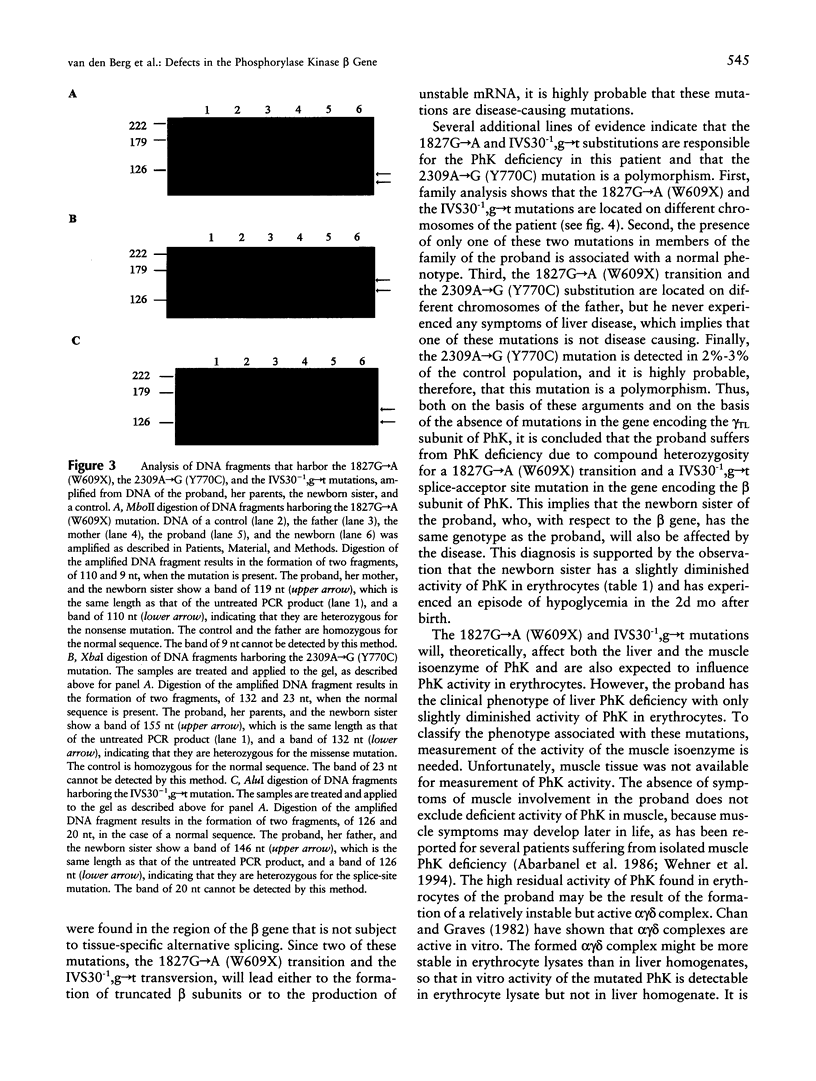Abstract
The association of autosomal recessive phosphorylase kinase deficiency in liver of a 3 1/2-year-old female child with mutations in the gene encoding the common part of the beta subunit of phosphorylase kinase is reported. The proband had a severe deficiency of phosphorylase kinase in liver, while the phosphorylase kinase activity in erythrocytes was only slightly diminished. She had no symptoms of muscle involvement. The complete coding sequences of the liver gamma subunit and of the beta subunit of phosphorylase kinase of the proband were analyzed for the presence of mutations, by either reverse-transcribed PCR or SSCP analysis. Three deviations from the normal sequence were found in the region encoding the common part of the beta subunit of phosphorylase kinase-namely, a 1827G-->A (W609X) transition, a 2309A-->G (Y770C) transition, and a deletion of nucleotides 2896-2911-whereas no mutations were detected in the sequence encoding the liver gamma subunit of phosphorylase kinase. The 1827G-->A mutation and the deletion both result in the formation of early stop codons. Investigation of DNA showed that the deletion is caused by a splice-acceptor site mutation (IVS30(-1),g-->t). Family analysis revealed that the 1827G-->A and IVS30(-1),g-->t substitutions are located on different parental chromosomes and that compound heterozygosity for these mutations segregates with the disease. The 2309A-->G mutation was detected in 2%-3% of the normal population. Thus, it is concluded that the deficiency of phosphorylase kinase in this proband is caused by compound heterozygosity for the 1827G-->A and the IVS30(-1),g-->t mutations and that the 2309A-->G mutation is a polymorphism. This implies that a defect in the sequence encoding the common part of the beta subunit of phosphorylase kinase may present as liver phosphorylase kinase deficiency.
Full text
PDF







Images in this article
Selected References
These references are in PubMed. This may not be the complete list of references from this article.
- Abarbanel J. M., Bashan N., Potashnik R., Osimani A., Moses S. W., Herishanu Y. Adult muscle phosphorylase "b" kinase deficiency. Neurology. 1986 Apr;36(4):560–562. doi: 10.1212/wnl.36.4.560. [DOI] [PubMed] [Google Scholar]
- Bender P. K., Dedman J. R., Emerson C. P., Jr The abundance of calmodulin mRNAs is regulated in phosphorylase kinase-deficient skeletal muscle. J Biol Chem. 1988 Jul 15;263(20):9733–9737. [PubMed] [Google Scholar]
- Chan K. F., Graves D. J. Rabbit skeletal muscle phosphorylase kinase. Catalytic and regulatory properties of the active alpha gamma delta and gamma delta complexes. J Biol Chem. 1982 May 25;257(10):5948–5955. [PubMed] [Google Scholar]
- Davidson J. J., Ozçelik T., Hamacher C., Willems P. J., Francke U., Kilimann M. W. cDNA cloning of a liver isoform of the phosphorylase kinase alpha subunit and mapping of the gene to Xp22.2-p22.1, the region of human X-linked liver glycogenosis. Proc Natl Acad Sci U S A. 1992 Mar 15;89(6):2096–2100. doi: 10.1073/pnas.89.6.2096. [DOI] [PMC free article] [PubMed] [Google Scholar]
- Francke U., Darras B. T., Zander N. F., Kilimann M. W. Assignment of human genes for phosphorylase kinase subunits alpha (PHKA) to Xq12-q13 and beta (PHKB) to 16q12-q13. Am J Hum Genet. 1989 Aug;45(2):276–282. [PMC free article] [PubMed] [Google Scholar]
- Hanks S. K. Messenger ribonucleic acid encoding an apparent isoform of phosphorylase kinase catalytic subunit is abundant in the adult testis. Mol Endocrinol. 1989 Jan;3(1):110–116. doi: 10.1210/mend-3-1-110. [DOI] [PubMed] [Google Scholar]
- Harmann B., Zander N. F., Kilimann M. W. Isoform diversity of phosphorylase kinase alpha and beta subunits generated by alternative RNA splicing. J Biol Chem. 1991 Aug 25;266(24):15631–15637. [PubMed] [Google Scholar]
- Heilmeyer L. M., Jr Molecular basis of signal integration in phosphorylase kinase. Biochim Biophys Acta. 1991 Sep 3;1094(2):168–174. doi: 10.1016/0167-4889(91)90005-i. [DOI] [PubMed] [Google Scholar]
- Jones T. A., da Cruz e Silva E. F., Spurr N. K., Sheer D., Cohen P. T. Localisation of the gene encoding the catalytic gamma subunit of phosphorylase kinase to human chromosome bands 7p12-q21. Biochim Biophys Acta. 1990 Jan 30;1048(1):24–29. doi: 10.1016/0167-4781(90)90017-v. [DOI] [PubMed] [Google Scholar]
- Kilimann M. W., Zander N. F., Kuhn C. C., Crabb J. W., Meyer H. E., Heilmeyer L. M., Jr The alpha and beta subunits of phosphorylase kinase are homologous: cDNA cloning and primary structure of the beta subunit. Proc Natl Acad Sci U S A. 1988 Dec;85(24):9381–9385. doi: 10.1073/pnas.85.24.9381. [DOI] [PMC free article] [PubMed] [Google Scholar]
- Maichele A. J., Burwinkel B., Maire I., Søvik O., Kilimann M. W. Mutations in the testis/liver isoform of the phosphorylase kinase gamma subunit (PHKG2) cause autosomal liver glycogenosis in the gsd rat and in humans. Nat Genet. 1996 Nov;14(3):337–340. doi: 10.1038/ng1196-337. [DOI] [PubMed] [Google Scholar]
- Saiki R. K., Gelfand D. H., Stoffel S., Scharf S. J., Higuchi R., Horn G. T., Mullis K. B., Erlich H. A. Primer-directed enzymatic amplification of DNA with a thermostable DNA polymerase. Science. 1988 Jan 29;239(4839):487–491. doi: 10.1126/science.2448875. [DOI] [PubMed] [Google Scholar]
- Scambler P. J., McPherson M. A., Bates G., Bradbury N. A., Dormer R. L., Williamson R. Biochemical and genetic exclusion of calmodulin as the site of the basic defect in cystic fibrosis. Hum Genet. 1987 Jul;76(3):278–282. doi: 10.1007/BF00283623. [DOI] [PubMed] [Google Scholar]
- Van den Berg I. E., Berger R. Phosphorylase b kinase deficiency in man: a review. J Inherit Metab Dis. 1990;13(4):442–451. doi: 10.1007/BF01799501. [DOI] [PubMed] [Google Scholar]
- Wehner M., Clemens P. R., Engel A. G., Kilimann M. W. Human muscle glycogenosis due to phosphorylase kinase deficiency associated with a nonsense mutation in the muscle isoform of the alpha subunit. Hum Mol Genet. 1994 Nov;3(11):1983–1987. doi: 10.1093/hmg/3.11.1983. [DOI] [PubMed] [Google Scholar]
- Whitmore S. A., Apostolou S., Lane S., Nancarrow J. K., Phillips H. A., Richards R. I., Sutherland G. R., Callen D. F. Isolation and characterization of transcribed sequences from a chromosome 16 hn-cDNA library and the physical mapping of genes and transcribed sequences using a high-resolution somatic cell panel of human chromosome 16. Genomics. 1994 Mar 15;20(2):169–175. doi: 10.1006/geno.1994.1150. [DOI] [PubMed] [Google Scholar]
- Wüllrich-Schmoll A., Kilimann M. W. Structure of the human gene encoding the phosphorylase kinase beta subunit (PHKB). Eur J Biochem. 1996 Jun 1;238(2):374–380. doi: 10.1111/j.1432-1033.1996.0374z.x. [DOI] [PubMed] [Google Scholar]
- Zander N. F., Meyer H. E., Hoffmann-Posorske E., Crabb J. W., Heilmeyer L. M., Jr, Kilimann M. W. cDNA cloning and complete primary structure of skeletal muscle phosphorylase kinase (alpha subunit). Proc Natl Acad Sci U S A. 1988 May;85(9):2929–2933. doi: 10.1073/pnas.85.9.2929. [DOI] [PMC free article] [PubMed] [Google Scholar]





